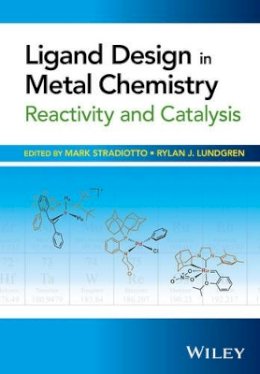
Stock image for illustration purposes only - book cover, edition or condition may vary.
Ligand Design in Metal Chemistry: Reactivity and Catalysis
Mark Stradiotto (Ed.)
FREE Delivery in Ireland
Description for Ligand Design in Metal Chemistry: Reactivity and Catalysis
Hardcover. Ligand Design in Metal Chemistry assembles a collection of cutting-edge chapters documenting the breadth and depth of modern ligand design, in diverse areas such as dinitrogen fixation, polymer synthesis, asymmetric catalysis, cross-coupling and proton reduction chemistry. Editor(s): Stradiotto, Mark; Lundgren, Rylan. Num Pages: 524 pages. BIC Classification: PN. Category: (P) Professional & Vocational. Dimension: 246 x 189. .
The design of ancillary ligands used to modify the structural and reactivity properties of metal complexes has evolved into a rapidly expanding sub-discipline in inorganic and organometallic chemistry. Ancillary ligand design has figured directly in the discovery of new bonding motifs and stoichiometric reactivity, as well as in the development of new catalytic protocols that have had widespread positive impact on chemical synthesis on benchtop and industrial scales.
Ligand Design in Metal Chemistry presents a collection of cutting-edge contributions from leaders in the field of ligand design, encompassing a broad spectrum of ancillary ligand classes and reactivity applications. Topics covered ... Read moreinclude:
- Key concepts in ligand design
- Redox non-innocent ligands
- Ligands for selective alkene metathesis
- Ligands in cross-coupling
- Ligand design in polymerization
- Ligand design in modern lanthanide chemistry
- Cooperative metal-ligand reactivity
- P,N Ligands for enantioselective hydrogenation
- Spiro-cyclic ligands in asymmetric catalysis
This book will be a valuable reference for academic researchers and industry practitioners working in the field of ligand design, as well as those who work in the many areas in which the impact of ancillary ligand design has proven significant, for example synthetic organic chemistry, catalysis, medicinal chemistry, polymer science and materials chemistry.
Show Less
Product Details
Publisher
John Wiley & Sons Inc
Place of Publication
New York, United States
Shipping Time
Usually ships in 7 to 11 working days
About Mark Stradiotto (Ed.)
Mark Stradiotto, Department of Chemistry, Dalhousie University, Canada Rylan Lundgren, Department of Chemistry, University of Alberta, Canada Both professors have a well-established track-record of working in the field of organometallic ligand design and catalysis, and have published extensively on the subjects of metal-catalyzed cross-coupling, novel transition-metal bond activation, and asymmetric catalysis. They are co-inventors of the now commercialized DalPhos ... Read moreligand family and have broad experience of the field of ligand design. Professor Stradiotto has worked in the field of organometallic chemistry for the past fourteen years. Professor Lundgren earned his PhD under the supervision of Prof Stradiotto at Dalhousie University in 2010. Following a PDF at MIT and Caltech with Prof. Greg Fu, Rylan accepted a faculty position at the University of Alberta (Canada). Show Less
Reviews for Ligand Design in Metal Chemistry: Reactivity and Catalysis
"Catalysis underpins both modern industrial and academic chemistry, improving reaction sustainability, shaping reaction selectivity and facilitating fundamentally new reaction pathways. While the focus is often on the showpiece metals themselves, the ligands are the true shapers of this reactivity. Stradiotto and Lundgren have curated a collection that certainly celebrates ligands across a wide array of applications. At over 400 pages ... Read moreacross 13 chapters written by world leaders in catalysis and ligand design, the book is a modern resource for those working in the area. The book opens with a chapter detailing the underlying key concepts that feature throughout the rest of the book. This is likely the only chapter which would serve the undergraduate student but as a stand-alone chapter would indeed provide a strong additional resource for final year students on a catalysis and/or coordination chemistry course. From there, each chapter captures a specific vignette of relevance to the authors. The overall book is by no means comprehensive in coverage, but it neither intends to be or indeed should be. Instead, it permits the reader to learn about specific topics in the key authors voice, and from a unified perspective of the ligand design... The book, as a secondary impact, also helps to showcase the important contribution Canadian researchers have made to catalysis and ligand design, with 6 of the 13 chapters written by authors at Canadian universities. In closing, the collection of articles found in Ligand Design in Metal Chemistry is certainly worthy of a book shelf spot for those working in the field of ligand design in catalysis. As the content of the book is necessarily focussed, this reviewer recommends a thorough read through the table of contents to ensure that chapters of particular interest are complemented by those that will introduce the reader to new areas." (AOC, Feb 2017) Show Less

.png)